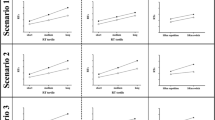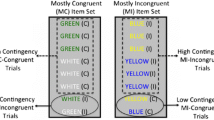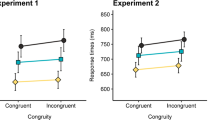Abstract
If given a relatively small number and asked to make a speeded parity judgment using the left and right responses, people typically respond faster with their left response. Conversely, if given a relatively large number, people usually respond faster with their right response. This finding, however, has primarily been shown using speeded tasks with response time as the primary measure. Here, we report an experiment testing if this remains to be the case in a non-speeded target identification. Using an object-substitution masking paradigm with no emphasis on response speed, number magnitude compatibility with the response hand influenced the accuracy of parity judgments. Given the non-speeded nature of the task, accuracy changes indicate that compatibility affects perception, rather than just response selection. This is explained using a common coding, feature integration approach in which stimuli and responses are represented in a common code and bidirectionally influence each other.



Similar content being viewed by others
Notes
For the remainder of this paper, ‘correspondence’ will refer to the relationship between the task-irrelevant spatial information and response hand while ‘compatibility’ will refer to the relationship between the task-relevant feature and response hand.
Of course, in Simon tasks the stimuli are generally static. The difference, however, is that the spatial information is not, strictly speaking, part of the stimuli so is not continuously processed while transforming the stimulus into a response.
References
Bae, G. Y., Choi, J. M., Cho, Y. S., & Proctor, R. W. (2009). Transfer of magnitude and spatial mappings to the SNARC effect for parity judgments. Journal of Experimental Psychology: Learning, Memory, and Cognition, 35, 1506–1521.
Blakemore, S. J., Wolpert, D. M., & Frith, C. D. (1998). Central cancellation of self-produced tickle sensation. Nature Neuroscience, 1, 635–640. doi:10.1038/2870.
Brainard, D. H. (1997). The psychophysics toolbox. Spatial Vision, 10, 433–436.
Cardoso-Leite, P., Mamassian, P., Schütz-Bosbach, S., & Waszak, F. (2010). A new look at sensory attenuation. Action–effect anticipation affects sensitivity, not response bias. Psychological Science, 21, 1740–1745.
De Jong, R., Liang, C.-C., & Lauber, E. (1994). Conditional and unconditional automaticity: a dual-process model of effects of spatial stimulus-response correspondence. Journal of Experimental Psychology: Human Perception and Performance, 20, 731–750. doi:10.1037/0096-1523.20.4.731.
Di Lollo, V., Enns, J. T., & Rensink, R. A. (2000). Competition for consciousness among visual events: the psychophysics of reentrant visual processes. Journal of Experimental Psychology: General, 129, 481–507.
Daar, M., & Pratt, J. (2008). Digits affect actions: the SNARC effect and response selection. Cortex, 44, 400–405.
Dehaene, S., Bossini, S., & Girauz, P. (1993). The mental representation of parity and number magnitude. Journal of Experimental Psychology: General, 122, 371–396.
Dehaene, S., Naccache, L., Le Clec’, H. G., Koechlin, E., Mueller, M., Dehaene-Lambertz, G., et al. (1998). Semantic priming. Nature, 395, 597–600.
Elsner, B., & Hommel, B. (2001). Effect anticipation and action control. Journal of Experimental Psychology: Human Perception and Performance, 27, 229–240.
Elsner, B., & Hommel, B. (2004). Contiguity and contingency in action–effect learning. Psychological Research, 68, 138–154.
Enns, J. T., & Di Lollo, V. (1997). Object substitution: a new form of masking in unattended visual locations. Psychological Science, 8, 135–139.
Fischer, M. H., Castel, A. D., Dodd, M. D., & Pratt, J. (2003). Perceiving numbers causes spatial shifts of attention. Nature Neuroscience, 6, 555–556.
Fitts, P. M., & Seegar, C. M. (1953). S-R compatibility: spatial characteristics of the stimulus and response codes. Journal of Experimental Psychology, 46, 199–210.
Gevers, W., Caessens, B., & Fias, W. (2005). Towards a common processing architecture underlying Simon and SNARC effects. European Journal of Cognitive Psychology, 17, 659–673.
Gevers, W., Ratinckx, E., De Baene, W., & Fias, W. (2006a). Further evidence that the SNARC effect is processed along a dual-route architecture: evidence from the lateralized readiness potential. Experimental psychology, 53, 58–68.
Gevers, W., Verguts, T., Reynvoet, B., Caessens, B., & Fias, W. (2006b). Numbers and space: a computational model of the SNARC effect. Journal of Experimental Psychology. Human Perception and Performance, 32, 32–44.
Goodhew, S. C., Pratt, J., Dux, P. E., & Ferber, S. (2013). Substituting objects from consciousness: a review of object substitution masking. Psychonomic Bulletin & Review, 20, 859–877.
Gozli, D. G., Goodhew, S. C., Moskowitz, J. B., & Pratt, J. (2013). Ideomotor perception modulates visuospatial cueing. Psychological research, 77, 528–539.
Herwig, A., Prinz, W., & Waszak, F. (2007). Two modes of sensorimotor integration in intention-based and stimulus-based actions. Quarterly Journal of Experimental Psychology, 60, 1540–1554.
Herwig, A., & Waszak, F. (2012). Action–effect bindings and ideomotor learning in intention- and stimulus-based actions. Frontiers in Psychology, 3, 444.
Hommel, B. (1998). Event files: evidence for automatic integration of stimulus-response episodes. Visual Cognition, 5, 183–216.
Hommel, B., Müsseler, J., Aschersleben, G., & Prinz, W. (2001). The theory of event coding (TEC): a framework for perception and action planning. The Behavioral and Brain Sciences, 24, 849–878. (discussion 878–937).
Hommel, B., Proctor, R. W., & Vu, K.-P. L. (2004). A feature-integration account of sequential effects in the Simon task. Psychological Research, 68, 1–17.
Kunde, W. (2004). Response priming by supraliminal and subliminal action effects. Psychological Research, 68, 91–96.
Moretto, G., & di Pellegrino, G. (2008). Grasping numbers. Experimental Brain Research, 188, 505–515.
Müsseler, J., & Hommel, B. (1997). Blindness to response-compatible stimuli. Journal of Experimental Psychology. Human Perception and Performance, 23, 861–872.
Notebaert, W., Gevers, W., Verguts, T., & Fias, W. (2006). Shared spatial representations for numbers and space: the reversal of the SNARC and the Simon effects. Journal of Experimental Psychology: Human Perception and Performance, 32, 1197–1207.
Pelli, D. G. (1997). The VideoToolbox software for visual psychophysics: transforming numbers into movies. Spatial Vision, 10, 437–442.
Pfister, R., Kiesel, A., & Hoffmann, J. (2011). Learning at any rate: action–effect learning for stimulus-based actions. Psychological Research, 75, 61–65.
Pfister, R., Schroeder, P. A., & Kunde, W. (2013). SNARC struggles: instant control over spatial–numerical associations. Journal of Experimental Psychology. Learning, Memory, and Cognition, 39, 1953–1958.
Prinz, W. (1997). Perception and action planning. European Journal of Cognitive Psychology, 9, 129.
Proctor, R. W., & Cho, Y. S. (2006). Polarity correspondence: a general principle for performance of speeded binary classification tasks. Psychological Bulletin, 132, 416–442.
Proctor, R. W., Miles, J. D., & Baroni, G. (2011). Reaction time distribution analysis of spatial correspondence effects. Psychonomic Bulletin & Review, 18(2), 242–266. doi:10.3758/s13423-011-0053-5.
Restle, F. (1970). Speed of adding and comparing numbers. Journal of Experimental Psychology, 83, 274–278.
Roussel, C., Hughes, G., & Waszak, F. (2014). Action prediction modulates both neurophysiological and psychophysical indices of sensory attenuation. Frontiers in Human Neuroscience, 8, 115.
Schwarz, W., & Keus, I. M. (2004). Moving the eyes along the mental number line: comparing SNARC effects with saccadic and manual responses. Perception & Psychophysics, 66, 651–664.
Shaki, S., & Fischer, M. H. (2008). Reading space into numbers–a cross-linguistic comparison of the SNARC effect. Cognition, 108, 590–599.
Shaki, S., & Fischer, M. H. (2014). Random walks on the mental number line. Experimental Brain Research, 232, 43–49.
Shaki, S., Fischer, M. H., & Petrusic, W. M. (2009). Reading habits for both words and numbers contribute to the SNARC effect. Psychonomic Bulletin & Review, 16, 328–331.
Simon, J. R. (1969). Reactions toward the source of stimulation. Journal of Experimental Psychology, 81, 174–176.
Stürmer, B., Leuthold, H., Soetens, E., Schröter, H., & Sommer, W. (2002). Control over location-based response activation in the Simon task: behavioral and electrophysiological evidence. Journal of Experimental Psychology. Human Perception and Performance, 28, 1345–1363.
Treisman, A. M., & Gelade, G. (1980). A feature-integration theory of attention. Cognitive Psychology, 12, 97–136.
van Dijck, J. P., & Fias, W. (2011). A working memory account for spatial–numerical associations. Cognition, 119, 114–119.
Wolfensteller, U., & Ruge, H. (2011). On the timescale of stimulus-based action–effect learning. Quarterly Journal of Experimental Psychology, 64, 1273–1289.
Wood, G., Willmes, K., Nuerk, H. C., & Fischer, M. H. (2008). On the cognitive link between space and number: a meta-analysis of the SNARC effect. Psychology Science Quarterly, 50, 489–525.
Wühr, P. (2005). Evidence for gating of direct response activation in the Simon task. Psychonomic Bulletin & Review, 12(2), 282–288.
Wühr, P., & Müsseler, J. (2001). Time course of the blindness to response-compatible stimuli. Journal of Experimental Psychology. Human Perception and Performance, 27, 1260–1270.
Acknowledgments
This research was supported by a Natural Science and Engineering Research Council of Canada in the form of a Discovery Grant awarded to Jay Pratt. We would like to thank two anonymous reviewers for their helpful comments regarding this paper.
Author information
Authors and Affiliations
Corresponding author
Rights and permissions
About this article
Cite this article
Huffman, G., Pratt, J. The effect of SNARC compatibility on perceptual accuracy: evidence from object substitution masking. Psychological Research 80, 702–709 (2016). https://doi.org/10.1007/s00426-015-0679-4
Received:
Accepted:
Published:
Issue Date:
DOI: https://doi.org/10.1007/s00426-015-0679-4




